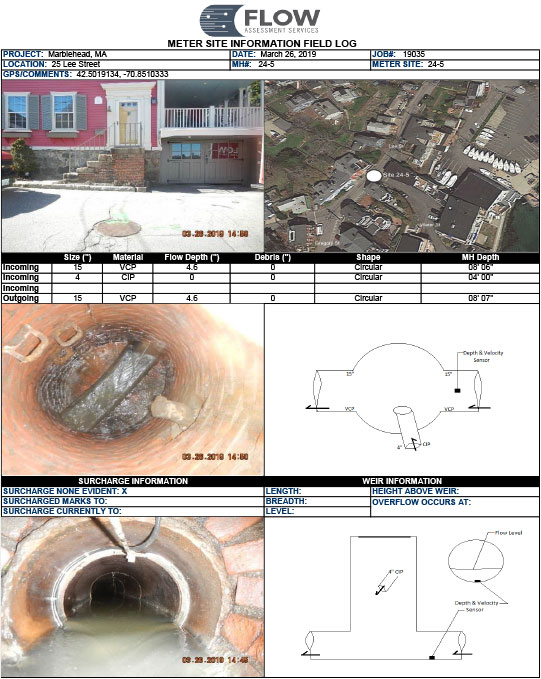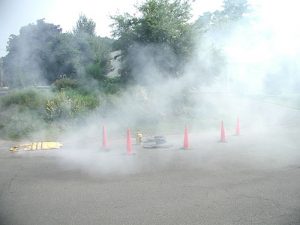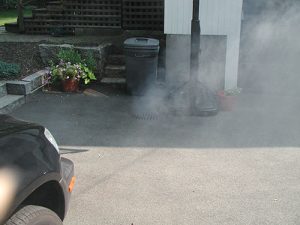There are three basic methods used by the sewer department to locate and identify sources of excess flow into the sanitary sewer system. These methods are:
- Flow metering
- Smoke testing, and
- Closed Circuit Television Inspection (CCTV).
Flow Metering
Flow metering is used to identify large areas of the sanitary sewer system that need additional inspection. Meters are installed in key manholes throughout the system and kept in place for weeks to record flow rates 24 hours a day. After this period, the changes in flow rates are compared to rainfall records to find patterns of precipitation and higher than average sanitary sewer flows.
The following field log form shows some details of a flow meter that was installed for Marblehead’s most recent flow study.

Smoke Testing
The next step in investigations is Smoke Testing. During smoke testing, non toxic smoke is blown into a manhole, and a team of observers will walk through a neighborhood looking for the smoke. The locations where smoke is escaping from the system point to locations where excess flow can enter the system. The team is searching in particular for catch basins, roof drains, and driveway drains with escaping smoke. The sewer department will always distribute notices to a neighborhood before smoke testing is conducted.
While the smoke used for this test is non toxic and non-staining, it is important to note if smoke is escaping through drains that are intended to connect to the sanitary sewer system. If the smoke is escaping a drain, this can indicated a trap that has dried out or improperly vented plumbing. If smoke can escape into your home, then toxic sewer gases can also escape. Regularly pour water down the drains in your home to keep the trap full and prevent this gas from entering your home.
Here are some images of smoke testing. As you can see, there can be quite a lot of smoke generated at the location where the smoke is blown into the manhole (left) and smoke escaping from a driveway drain (right). This drain would be revisited to confirm it is incorrectly connected to the sewer and must be re-routed to the storm water system or a drywell.
CCTV Inspection
Closed Circuit Television (CCTV) inspections are conducted to inspect the sanitary sewer pipes from the inside. CCTV inspectors are looking for blockages, roots, cracks, leaks, and excessive flow from individual services. CCTV inspections are conducted from a truck containing the inspection equipment and parked over a manhole. A camera is mounted on a small robotic car, which is connected to the controls inside the truck. The camera is inserted into the pipe, and then driven down the pipe while the inspection is recorded. Some specialized cameras are equipped with a small extendable arm to inspect an individual sanitary sewer service.
This video clip shows part of a typical CCTV inspection video. This flow looks suspicious, and would be revisited for further investigation. Imagine how much flow this would add up to over the course of a day, week or year! That equates to unnecessary treatment costs borne by the Commission and passed onto the rate payers.


